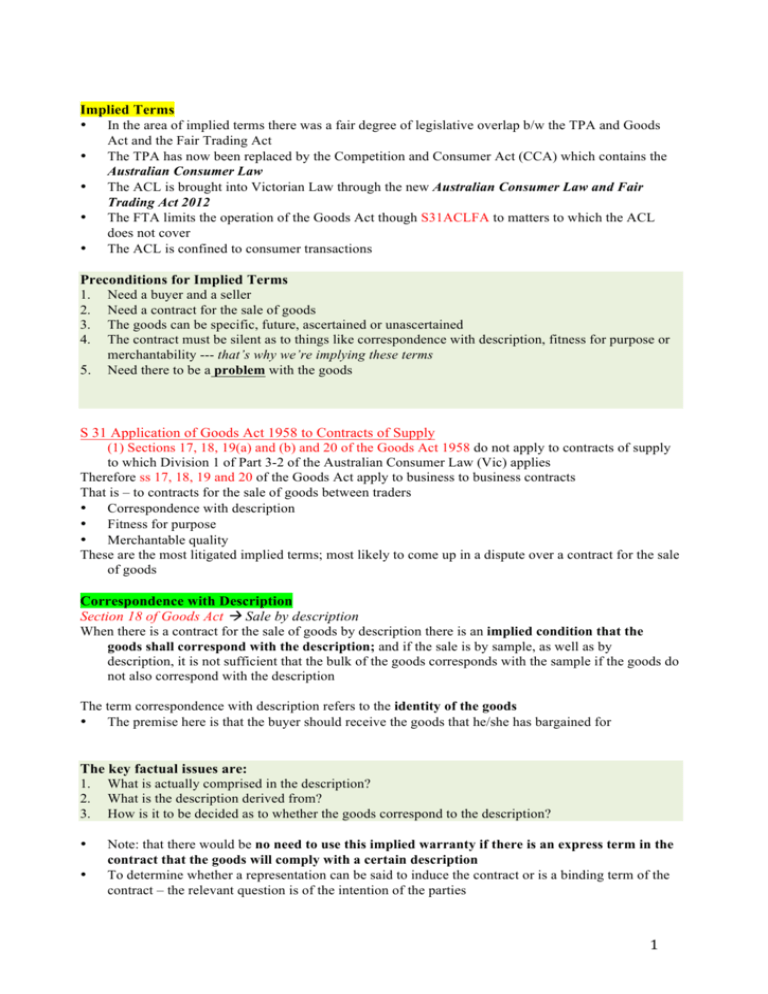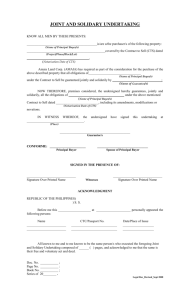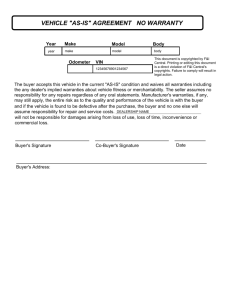Implied Terms • In the area of implied terms there was a fair degree
advertisement

Implied Terms • In the area of implied terms there was a fair degree of legislative overlap b/w the TPA and Goods Act and the Fair Trading Act • The TPA has now been replaced by the Competition and Consumer Act (CCA) which contains the Australian Consumer Law • The ACL is brought into Victorian Law through the new Australian Consumer Law and Fair Trading Act 2012 • The FTA limits the operation of the Goods Act though S31ACLFA to matters to which the ACL does not cover • The ACL is confined to consumer transactions Preconditions for Implied Terms 1. Need a buyer and a seller 2. Need a contract for the sale of goods 3. The goods can be specific, future, ascertained or unascertained 4. The contract must be silent as to things like correspondence with description, fitness for purpose or merchantability --- that’s why we’re implying these terms 5. Need there to be a problem with the goods S 31 Application of Goods Act 1958 to Contracts of Supply (1) Sections 17, 18, 19(a) and (b) and 20 of the Goods Act 1958 do not apply to contracts of supply to which Division 1 of Part 3-2 of the Australian Consumer Law (Vic) applies Therefore ss 17, 18, 19 and 20 of the Goods Act apply to business to business contracts That is – to contracts for the sale of goods between traders • Correspondence with description • Fitness for purpose • Merchantable quality These are the most litigated implied terms; most likely to come up in a dispute over a contract for the sale of goods Correspondence with Description Section 18 of Goods Act ! Sale by description When there is a contract for the sale of goods by description there is an implied condition that the goods shall correspond with the description; and if the sale is by sample, as well as by description, it is not sufficient that the bulk of the goods corresponds with the sample if the goods do not also correspond with the description The term correspondence with description refers to the identity of the goods • The premise here is that the buyer should receive the goods that he/she has bargained for The key factual issues are: 1. What is actually comprised in the description? 2. What is the description derived from? 3. How is it to be decided as to whether the goods correspond to the description? • • Note: that there would be no need to use this implied warranty if there is an express term in the contract that the goods will comply with a certain description To determine whether a representation can be said to induce the contract or is a binding term of the contract – the relevant question is of the intention of the parties ! 1! • • • Did the parties intend for those words to constitute part of the contract? Oscar Chess Ltd v Williams (1957) 1 WLR 370 Test is whether a reasonably intelligent bystander would think that a promise was intended Look at the whole of the evidence surrounding the transaction Description A Sale by “Description” Can be unascertained or specific goods (though generally concerned with specific in relation to implied term) • Bought by the buyer in reliance on the description • Although reliance is not mentioned in s18 it is a necessary consequence of the requirement that the sale be ‘by description’ • Traves: It is possible to sell specific goods with no description – an article may be sold by its presence and the buyer take the risk that the article is what they think it is • BUT usually sold with some description such as a stone sold as a jewel not costume jewelry and a thoroughbred sold as a thoroughbred not a work horse General Points ! Sale in a self- service store will constitute a sale by description provided goods are described in some way on the outside of the packaging or by sign, notice or label – Benjamin’s sale of Goods ! There is no distinction between self selection and a sale assistant handing over an article in response to a request ! The good’s characteristics which would be apparent on reasonable examination are unlikely to be intended by the parties to form part of the description by which the goods were sold, even if those characteristics are mentioned in references in the contract to the goods that are its subject matter: Gill & Duffus SA v Berger & Co Inc • • • • • • Grant v Australian Knitting Mills Facts: Buyer contracted dermatitis from woolen underwear The buyer sued the retailer on basis that it had breached the implied conditions as to merchantability which also requires that there had been a sale by description Grant had self-selected the underwear from the shelf But the defect in question here – the existence of a chemical; free sulphite, was not discoverable on a basic examination Held: Court held that there had been a sale by description, at least to the extent that the description on the box delineates the good and describes the kind of clothing to be bought In the HC per Dixon J: When the ground on which the goods are selected or identified is then correspondence to a description and when therefore the buyer primarily relied on their classification or possession of attributes. Notwithstanding that they are specific goods they are still bought by description Elder Smith Goldsborough Mort v McBride (1976) 2 NSWLR 631 Facts: Bull was seen and selected but was sold as a ‘breeding bull’. • Both the buyer and the seller intended that the animal be a stud bull – ie that it be used for breeding purposes. • After the sale it became apparent that the bull was not fertile – it was argued by the buyers that the sale was a sale by description and the relevant description in the catalogue was a ‘breeding bull.’ Held: Sheppard J in the NSW Supreme Court found that (i) there was no express term in the contract but that (ii) the intention was that the bull be a stud breeding bull. • The sterility of the bull would not have been apparent on an outward examination. • Sheppard J did note that a sale by description may be less arguable where the goods have been inspected – Barr v Gibson, Varley v Whipp were not cases where the buyer was able to inspect the goods. ! 2! • • • But in cases like Elder Smith, and Thornett v Beers [1919] 1 KB 486, that principle cannot apply where “the deviation of the goods from the description is not apparent.” The defect was not apparent but it meant that the goods did not conform to the description. Condition as to description was breached Harlington & Leinster Enterprises Ltd v Christopher Hull Fine Art Ltd [1990] 3 WLR 13. Facts: Painting sold from one art dealer to another. • The question for the court was whether the name on the painting “Munter” formed part of the description of the painting on which the buyer relied when deciding to buy the painting. • The painting was not a “Munter” painting. • The painting was described as a Munter painting. • However, the seller made it very clear that he was not an expert in Munter’s paintings. • The seller appeared to rely on the knowledge of the buyer’s employee. • A majority of the Court of Appeal held that the buyer could not have reasonably relied on the name on the painting • Must look at the whole of the contract to determine which characteristics of the thing are intended to be its description. • Parties did not have a common intention that the authenticity of the name Munter was a term of the contract. • The test is objective. • Nourse LJ on the concept of a sale by description: • Is it necessary that the buyer has not seen the goods as per Varley v Whipp [1900] 1 QB 513. • “Other authorities show that s 13(1) may apply to a contract for the sale of specific goods which have been seen by the buyer, provided that their deviation from the description is not apparent on a reasonable examination.” • The UK section 13, the equivalent of s18 of the Goods Act, is not confined to situations where the buyer has not seen the goods. • See Couchman v Hill [1947] 1 All ER 103 – plaintiff purchased a heifer described as unserved. It was pregnant and later died from carrying a calf at too young an age. The description as “unserved” was held to be a condition. • Gill & Duffus SA v Berger & Co Inc [1984] 1 All ER 438 at 445--446, Lord Diplock: • • • • • “. . . while ''description'' itself is an ordinary English word, the Act contains no definition of what it means when it speaks in that section of a contract for the sale of goods being a sale ''by description''. One must look to the contract as a whole to identify the kind of goods that the seller was agreeing to sell and the buyer to buy ..” How necessary is reliance? Nourse LJ: Agreed with the criticisms of reliance but noted that in reality reliance is a necessary part of a sale by description. “The description must have a sufficient influence in the sale to become an essential term of the contract and the correlative of influence is reliance. Indeed, reliance by the buyer is the natural index of a sale by description.” “.. there cannot be a contract for the sale of goods by description where it is not within the reasonable contemplation of the parties that the buyer is relying on the description.” Quality or Description? What is the content of the description? • Description means a statement of kind, class or species which the article belongs • Must be a statement as to the essential or specific nature of the thing sold • It should not be merely a statement as to the quality, state or other attribute • Taylor v Combined Buyers Ltd (1924) NZLR 627 • There is a difference b/w identity- which means description and quality – which does not mean description ! 3! • • • • • • • • • • • Taylor v Combined Buyers Ltd at 639-40. If I contract to buy ‘a cask of port wine’ but I get beer instead – there is difference of kind so there is a breach of contract. But if I contract to buy ‘a cask of port wine in sound condition’ and get one in poor condition – I am not entitled to reject the goods as they conform to the description and there is only a difference of quality, state or condition – I may seek a remedy under ‘not merchantable’. If I contract to buy specific chairs described as ‘set of antique mahogany chairs’ and receive modern imitations. Can reject – difference of kind not quality. Traves: oysters not fit for human consumption might not be “oysters”. EXAMPLES If you contract to buy a stud bull but on delivery the bull cannot perform copulation – there is a breach of description because part of the essential nature of a stud bull so differs in kind not just quality: Cotter v Luckie [1918] NZLR 811. BUT if contract for a ‘pedigree Jersey bull’ – on delivery sterile, not a breach of description within the strict meaning of ‘pedigree’: Dell v Quilty [1924] NZLR 1270. If contract to buy a 14 horse power engine, but engine is less that than it may not constitute a breach: Parson v Sexton. Words that describe the purpose for which goods are suitable will usually not form part of the description of the goods for the purpose of s18, otherwise the implied condition as to fitness for purpose would be redundant. Note, may be exceptions where general purpose of goods is an element of description of the goods eg. oysters not fit for eating might not conform with their description as oysters. i.e. there may be an overlap with fitness for purpose. Correspondence with Description Do the goods correspond with their description? • • • This is a question of fact in the circumstances of the case: Ashington Piggeries Ltd v Christopher Hill Ltd. In determining the meaning of the words comprising the description follow the ordinary rules of contractual interpretation – Ashington Piggeries; Codelfa. Industry or market terms might be relevant. Ashington Piggeries Ltd v Christopher Hill Ltd [1972] AC 441. Facts: Christopher Hill sold animal foods, entered into contract to sell mink food to Ashington who ran a mink farm • Ashington supplied a formula for Hill to make up the food called “King Size” • Hill had no particular expertise with respect to mink • Hill entered into K with Nordsildmel for them to supply Norwegian herring meal of 'fair average quality of the season' for the compound. • The herring meal contained dimethylnitrosamine (DMNA) unbeknown to any of the parties • The DMNA was highly toxic to mink and the mink died • The chemical reaction which produced the toxic substance in the course of manufacture was unthought-of of by Nord and Hill • Christopher Hill, the seller, sued Ashington Piggeries for the price of the goods. • Ashington Piggeries counter-claimed for damages for breach of contract alleging that the 'King Size' did not correspond with its description, was not reasonably fit for the purpose, nor of merchantable quality. HELD that there was no breach of the implied condition that the goods correspond with their description • There was a sale by description – ie that the food would be made up according to the formula • The herring meal was in the formula • The presence of DMNA only went to the quality or fitness for purpose of the herring meal and not to its description. ! 4!








